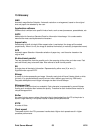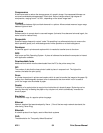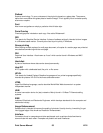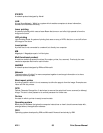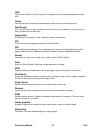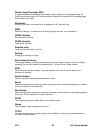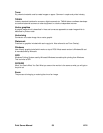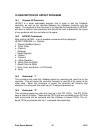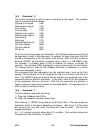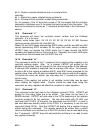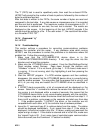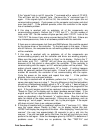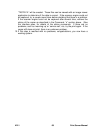
Print Server Manual 67 A741
If the “signals” byte is not 00, issue the “i” command with a value of FF HEX.
This will clear out the “signals” byte. Re-issue the “s” command type 01
again. If the signals byte is still not 00, the controller and copier are not
communicating properly. Cycle power on the computer and copier and start
over from step 1. If the problem persists, either the controller or the copier
has a hardware problem.
6. If this step is reached with no problems, all of the components are
communicating properly. Perform the “t” FIFO test (“f”). For the number of
tests, enter 100. For the number of bytes per test, enter 131072. Look at the
“FIFO.TST” file to see if any errors occurred during the FIFO test. If there are
any miscompare errors, there is a hardware problem with the controller.
If there are no miscompares, but there are DMA failures, this could be caused
by the device driver or the controller. Try the test again in this case. If there
are still failures, the components are not working properly and data transfers
will be unreliable.
7. If this step is reached with no problems, all of the components are
communicating properly and the controller and driver are working properly.
Make sure the copier shows “Ready to Copy” on its display. Perform the “t”
test button print (“b”). LBTEST will not show any progress for this test
because all of the control is done within the controller. If the controller is
communicating with the copier, an 8.5” wide test pattern will be printed. This
pattern should repeat for approximately 18” in length. If nothing happens
within 90 seconds, perform this test again. If there is still no printout within
another 90 seconds, the controller is not communicating with the copier.
Cycle the power on the copier and repeat from step 1. If the problem
persists, there is an unknown problem.
8. If this step is reached with no problems, perform the “t” test print (“p”). The
same rules apply here as in step 7. The only difference is that the test pattern
should be a checkerboard pattern which is 16” x 16” with a 1” band of gray at
the top of the pattern. The LBTEST program will display the progress of the
print. If the print engine could not be captured, make sure the copier shows
“Ready to Copy” on its display and try again (perhaps several times). If the
engine could not be captured after several tries, retrieve the status of the
copier as described in the Command: “s” section above. (See the interface
spec. for details of the status commands.) If there are no problems, such as
‘warming up’, ‘out of paper’, “service call’, etc, try the print again. If the copier
still does not print, there is an unknown problem.
9. If this step is reached with no problems, perform the “t” test scan (“s”). Make
sure the copier shows “Ready to Copy” on its display before this test.
LBTEST will display the progress of the scan. After displaying “Insert plot into
scanner”, the user has approximately 25 seconds to set a plot into the
scanner. If no plot has been set by that time, the test will end and you must
perform the test again. Note the messages given by LBTEST to determine if
problems occur. If there are no problems, the files “TEST.FIL” and



